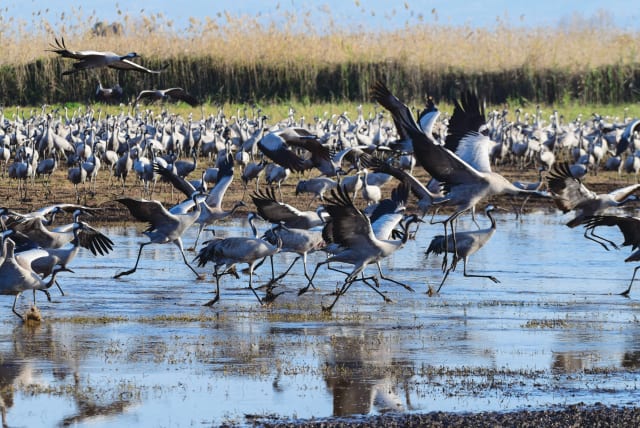Fireworks are not for birds! Causes confusion for migrating birds during flight

Birds are very sensitive and can easily be confused, suffer accidents, and their path shifted by noises like fireworks.
Connecting Asia and Africa with a corridor that is one of the world’s most important and busiest migration flyways, Israel sees more than 500 million birds representing 550 species that fly over twice a year, in the spring and the fall.
The birds are very sensitive and can easily be confused, suffer accidents and their path shifted by noises like the fireworks that are also displayed on our Independence Day Eve celebrations. (We can’t do much about the missiles and rockets that have been hurled at us for decades by Hamas terrorists and our retaliation against them).
Fireworks are important elements of celebrations globally, but little is known about their effects on wildlife. The synchronized and extraordinary use of fireworks on New Year’s Eve triggers strong flight responses in birds.
Now, an international study led by researchers at the University of Amsterdam has been published in the journal Frontiers in Ecology and the Environment under the title “Fireworks disturbance across bird communities.” They call for the establishment of large fireworks-free zones around New Year’s Eve on December 31st.
Birds affected by fireworks

The birds are affected by the mass use of fireworks on New Year's Eve up to a distance of 10 km away. With data from weather radars and bird counts. the team revealed how many birds take off immediately after the start of the fireworks, at what distance from fireworks this occurs and which species groups mainly react.
“We already knew that many water birds react strongly, but now we also see the effect on other birds throughout the Netherlands,” said Ecologist Bart Hoekstra of the Institute for Biodiversity and Ecosystem Dynamics and colleagues who call for large fireworks-free zones around the world.
On New Year’s Eve, an average of 1,000 times as many birds are in the air close to where fireworks are set off as on other nights – with peaks of 10,000 to 100,000 times the normal number of birds. The effects are strongest within the first five km of fireworks, but up to 10 km there are still an average of at least 10 times as many birds flying as normal.
“Birds take off as a result of an acute flight response due to sudden noise and light. In a country like the Netherlands, with many wintering birds, we are talking about millions of birds being affected by the lighting of fireworks,’ he added.
Last year, other researchers discovered that geese are so affected by fireworks that they spend an average of 10% longer looking for food than normal during at least the next 11 days. They apparently need that time to replenish the lost energy or to compensate for the unknown foraging area in which they have ended up, after fleeing from the fireworks. They already knew that many water birds react strongly, but it was still unclear how birds outside these waterbodies react to fireworks.
Using the data, Hoekstra was able to calculate how many birds take off immediately after the start of the fireworks, at what distance from fireworks this happens, and which species groups mainly react. Almost 400,000 birds take off immediately at the start of the fireworks on December 31 and larger birds in open areas in particular fly around for hours after and at remarkable altitudes.
“Larger birds such as geese, ducks and gulls fly to a height of hundreds of meters due to the large-scale discharge of fireworks and remain in the air for up to an hour. There is a risk that they will end up in bad winter weather, or that they will not know where they are flying due to panic and accidents could occur,” Hoekstra explained.
Because 62% of all birds in the Netherlands live within a radius of 2.5 km of inhabited areas, the consequences of fireworks are high for all birds throughout the country. ‘Flying requires a lot of energy, so ideally birds should be disturbed as little as possible during the cold winter months. Measures to ensure this are especially important in open areas such as grasslands, where many larger birds spend the winter. The effects of fireworks on birds are less pronounced near forests and semi-open habitats. In addition, smaller birds such as tits and finches live there, which are less likely to fly away from disturbance,' the authors wrote.
Buffer zones could be smaller in areas where light and sound travel less far, such as near forests. Furthermore, fireworks should mainly be lit at central locations in built-up areas, as far away from birds as possible. It would be best for birds if we moved towards light shows without sound, such as drone shows or decorative fireworks without very loud bangs, they concluded.
Ear-splitting fireworks cause trauma to Holocaust survivors as well as dogs and other pets. Some Israeli cities have switched to silent fireworks, so this practice at least should be implemented around the country for Independence Day even if mayors don’t agree to stop the lights.
Jerusalem Post Store
`; document.getElementById("linkPremium").innerHTML = cont; var divWithLink = document.getElementById("premium-link"); if (divWithLink !== null && divWithLink !== 'undefined') { divWithLink.style.border = "solid 1px #cb0f3e"; divWithLink.style.textAlign = "center"; divWithLink.style.marginBottom = "15px"; divWithLink.style.marginTop = "15px"; divWithLink.style.width = "100%"; divWithLink.style.backgroundColor = "#122952"; divWithLink.style.color = "#ffffff"; divWithLink.style.lineHeight = "1.5"; } } (function (v, i) { });
